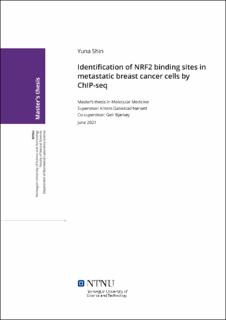| dc.description.abstract | Background: Nuclear factor erythroid 2-related factor 2 (NRF2) is a transcription factor that
is indicated to be an important component in promoting cancer metastasis. Accordingly, the
role of the transcription factor has been investigated in diverse types of aggressive cancer.
However, a comprehensive identification of NRF2 functions in metastatic breast cancer is
rather limited despite being one of the leading causes of death worldwide.
Objective: This study aims to identify NRF2 binding sites in 66cl4 murine metastatic breast
cancer cell line by chromatin immunoprecipitation sequencing (ChIP-seq) to contribute to the
understanding of how NRF2 contributes to aggressive breast cancer development.
Results: The genome-scale investigation was conducted with 66cl4 NT cells that constitutively
express NRF2 and 66cl4 NRF2 KD cells that are depleted in NRF2. The ChIP procedure was
initially optimized to suit the biological conditions of the 66cl4 cell line. The tailored method
produced six biological ChIP replicates where five were selected for high throughput
sequencing following quality control. Grouped samples were pooled for bioinformatical
analyses which enriched 94 significant ChIP-seq peaks in NRF2 antibody precipitated-66cl4
NT samples whereas only one peak was detected in 66cl4 NRF2 KD 3B7. A total of 40 known-
NRF2-regulated genes were identified in vicinity of 35 peaks, while the remaining 59 have not
been previously identified. Selected peaks were validated using ChIP-qPCR. The results
indicate a possible finding of novel NRF2-binding sites in 66cl4 cells.
Discussion: The 94 ChIP-peaks are NRF2-binding sites with both known and novel NRF2-
targeted genes located in proximity. This was additionally verified as majority of the peaks
were positioned in intronic and intergenic regions which are in line with large-scale
transcription factor-binding site studies. Intriguingly, the present study shows that NRF2 are
involved in extensive set of functions such as drug metabolism, multi-drug resistance, heme
homeostasis and local immune microenvironment through regulating its target genes. Several
of the genes were further identified to be linked with metastatic breast cancer. These results
extend upon existing evidence to the complex role NRF2 takes in breast cancer. | |
